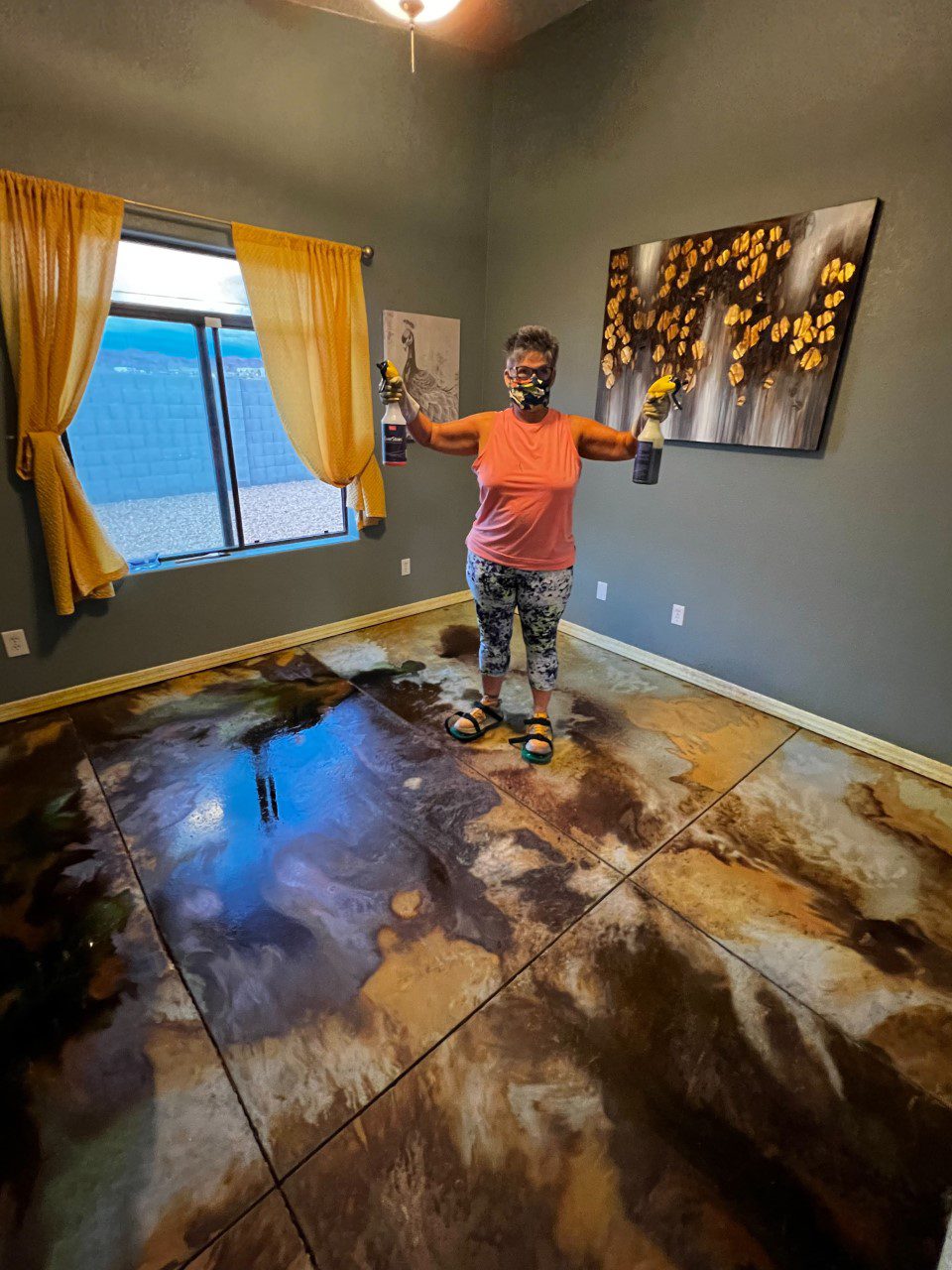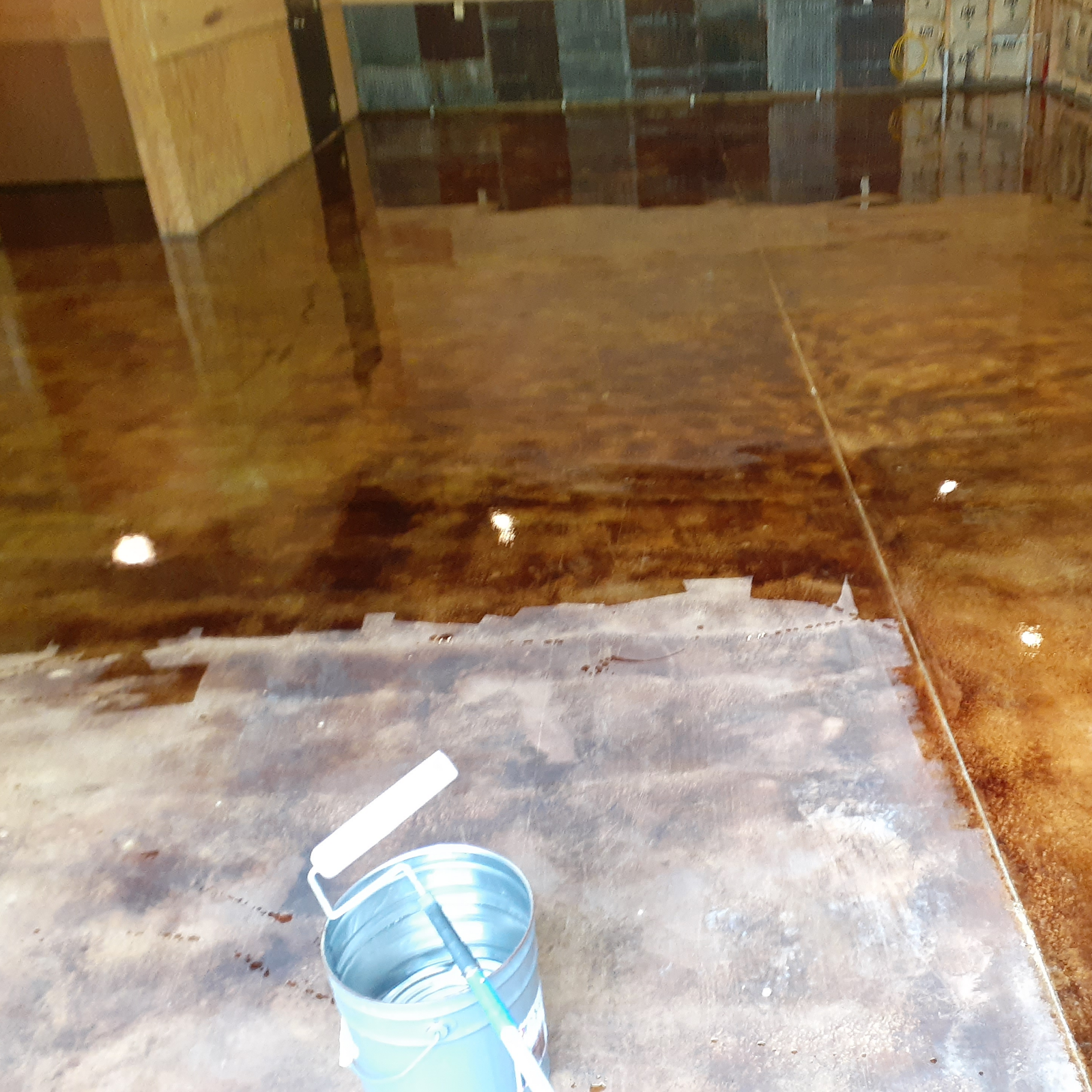All Concerning Stained Concrete: A Comprehensive Guide to Its Advantages and Applications
Stained concrete has emerged as a preferred selection for both domestic and commercial areas. Its ability to incorporate visual allure with practicality makes it a fascinating alternative. Numerous discoloration methods use a variety of colors and finishes, permitting for modification. Nonetheless, the advantages extend beyond appearance. Recognizing its applications and maintenance needs is essential for any individual considering this functional product. The subtleties of stained concrete welcome additionally expedition.
What Is Stained Concrete?

Discoloration can be used to numerous surfaces, including floorings, driveways, and patios, making it a versatile choice for both interior and outdoor spaces. The therapy can achieve a series of appearances, from earthy tones to bold, modern layouts. Unlike paint, stained concrete preserves its look over time, as it ends up being an integral component of the concrete itself. On the whole, stained concrete acts as an effective approach for transforming ordinary concrete into visually striking surface areas.
Advantages of Stained Concrete
Stained concrete deals substantial benefits, specifically in aesthetic appeal and sturdiness - stained concrete floors. Its lively shades and one-of-a-kind patterns improve the visual charm of any type of area, making it a prominent choice for both household and commercial applications. Additionally, the long life of stained concrete assurances that it stays a useful investment gradually, resisting damage
Visual Charm
One of the most compelling advantages of utilizing stained concrete is its amazing aesthetic appeal. Stained concrete offers an one-of-a-kind and versatile look that can complement various style styles, from modern-day to rustic. The mixture of lively colors and elaborate patterns permits homeowners and designers to produce personalized surface areas that can boost the overall ambiance of a space. Unlike conventional flooring alternatives, stained concrete can mimic the appearance of natural rock or polished marble, offering an upscale look without the associated costs. In addition, the glossy coating alternatives can mirror light, further brightening interiors. This versatility makes stained concrete a popular choice for both domestic and industrial applications, where visual effect is paramount.
Resilience and Long life
The excellent aesthetic qualities of stained concrete are enhanced by its impressive resilience and long life - stained concrete floors. Stained concrete surface areas are immune to damage, making them suitable for high-traffic locations both inside and outdoors. Their durable nature indicates they can stand up to extreme weather conditions, including extreme temperature levels, rainfall, and UV direct exposure, without considerable degradation. On top of that, stained concrete requires very little upkeep compared to other flooring options, as it does not need constant securing or redecorating. This longevity not just minimizes substitute expenses but likewise adds to a lasting building method. In general, stained concrete supplies a long-lasting remedy that incorporates aesthetic charm with sensible benefits, ensuring its worth with time
Different Kinds Of Staining Strategies
Various staining methods can markedly impact the visual qualities of concrete surface areas. The 3 primary approaches include acid staining, which responds chemically with the concrete, water-based discoloration, which uses a more comprehensive variety of shades, and overlay staining alternatives that give a fresh surface area. Each technique has unique characteristics and applications that provide to different layout preferences and project needs.
Acid Staining Technique
How can homeowners transform plain concrete surface areas into aesthetically striking functions? One efficient method is acid discoloration, a popular strategy that boosts the all-natural charm of concrete. This procedure involves using a remedy of water, hydrochloric acid, and metallic salts to the concrete surface. As the acid responds with the lime present in the concrete, it produces abundant, variegated colors that look like marble or rock. Acid staining is recognized for its longevity and resistance to fading, making it a resilient option for both interior and outdoor applications. It is important to note that the outcomes can vary based on the original concrete color and structure. Appropriate application and sealing are essential for achieving the desired aesthetic and durability
Water-Based Discoloration Technique
A prominent option to acid discoloration, the water-based staining method uses property owners a flexible means to improve concrete surface areas. This technique makes use of water-soluble dyes and pigments, permitting a large range of shades and finishes. Unlike acid discolorations, water-based stains can be put on unsealed concrete and supply an easier Extra resources cleanup process. The results can accomplish a much more uniform appearance and can be layered to produce one-of-a-kind results. In addition, water-based spots are usually much less toxic and discharge fewer unpredictable natural compounds (VOCs), making them much more eco-friendly. Homeowners might value the capacity to customize their concrete surfaces with different shades, enabling for creative expression while keeping durability and durability in their flooring choices.
Overlay Staining Options
Various overlay discoloration options exist for property owners aiming to invigorate their concrete surface areas. One prominent selection is acid discoloration, which reacts chemically with the concrete to produce abundant, variegated colors. An additional choice is water-based staining, providing a wider shade combination and easier application. In addition, concrete overlays can be combined with stencils for intricate layouts, enhancing visual appeals. For a more distinctive surface, property owners might consider making use of stamped overlays that mimic natural materials like stone or tile. Each method provides special advantages, from durability to modification, permitting a tailored touch. Inevitably, the selection of overlay discoloration depends upon the preferred look and the condition of the existing concrete, making sure a refreshed and appealing surface area.
Applications of Stained Concrete
Stained concrete offers a functional option for numerous applications, improving both aesthetic allure and capability. This product is generally made use of in household, industrial, and commercial settings, making it a prominent choice amongst engineers and designers. In homes, stained concrete can work as elegant flooring or exterior patio areas, offering an innovative look while staying durable.
In business rooms, such as retailers and dining establishments, stained concrete adds to a modern ambiance and can withstand hefty foot web traffic. Furthermore, stained concrete is significantly made use of in public rooms like parks and walkways, where its ability to mimic all-natural rock or various other products adds aesthetic interest.
Furthermore, stained concrete is perfect for pool decks and driveways, providing a slip-resistant surface that is very easy to preserve. In general, the adaptability of stained concrete makes it suitable for many settings, catering to varied preferences and demands.
Upkeep and Look After Stained Concrete
Correct maintenance assures the long life and elegance of stained concrete surfaces. Normal cleansing is necessary; utilizing a mild detergent and water with a soft-bristle brush aids eliminate dirt and crud without damaging the coating. It is suggested to prevent severe chemicals that can remove the discolor or sealant.
Sealing stained concrete is essential for defense against wetness, discolorations, and wear. A premium sealant should be reapplied every one to 3 years, relying on the web traffic and direct exposure the surface area sustains. Additionally, addressing spills immediately will avoid discoloration and discoloration.

Cost Factors To Consider for Stained Concrete Projects
When planning a discolored concrete project, spending plan considerations play an important duty in figuring out the total cost. The expenditures related to stained concrete can vary considerably based on a number of factors. The dimension of the area to be stained directly visit their website affects product and labor prices. Bigger rooms will naturally call for more sources. Second, the kind of tarnish picked-- acid-based or water-based-- can affect pricing, with acid spots frequently being much more pricey. In addition, the complexity of the style, consisting of patterns or numerous colors, can boost labor costs. Preparation work, such as cleansing and grinding the concrete surface area, includes in the first expenses as well. Finally, the choice in between do it yourself installation and working with an expert contractor will further influence the budget plan. Understanding these aspects makes it possible for house owners to make informed monetary decisions regarding their stained concrete tasks, ensuring they achieve the wanted visual within their economic ways.
Tips for Selecting the Right Stained Concrete for Your Room
Choosing the appropriate stained concrete for a details space involves mindful reflection of various factors past just budget plan. One must examine the designated use of the area. High-traffic zones may require even more resilient coatings, while attractive applications can focus on appearances.
The shade scheme is one more crucial aspect; the picked shades should harmonize with existing decor and lights. It's additionally essential to take into consideration the surface area texture, as smooth surfaces can boost refinement, while distinctive choices may guarantee safety in damp areas.
Regional environment and environmental problems play a substantial role in the longevity and upkeep of stained concrete, influencing the option of sealers and finishes.
Lastly, seeking advice from experts can provide useful insights customized to particular requirements, ensuring the option of the ideal stained concrete that lines up with both performance and style.

Often Asked Concerns
Can Stained Concrete Be Applied Over Existing Flooring?
Stained concrete can undoubtedly be used over existing flooring, supplied the surface is stable and appropriately prepared. This technique enables a visual upgrade without the need for complete elimination of the original flooring products.
Exactly How Lengthy Does Stained Concrete Last?
Stained concrete can last for years when correctly maintained. Aspects such as website traffic, ecological problems, and application strategies significantly influence its durability, with lots of installations continuing to be lively and undamaged for 10 to 30 years.
Is Stained Concrete Slippery When Damp?
Stained concrete can be unsafe when damp, as the coating may produce a smooth surface. Making use of non-slip ingredients or distinctive finishes can mitigate this problem, improving safety without endangering the visual appeal of the concrete.
Can I Discolor Concrete Myself, or Should I Employ a Specialist?
The choice to discolor concrete directly or work with a professional rest on ability degree and task intricacy. While DIY staining can conserve cash, experts ensure excellent outcomes, specifically for intricate layouts or big surface areas.
What Color styles Are Offered for Stained Concrete?
The variety of shades readily available for stained concrete includes earthy tones like browns and tans, dynamic tones such as reds and blues, and softer hues like pastels. This combination permits for imaginative, customized layout options.